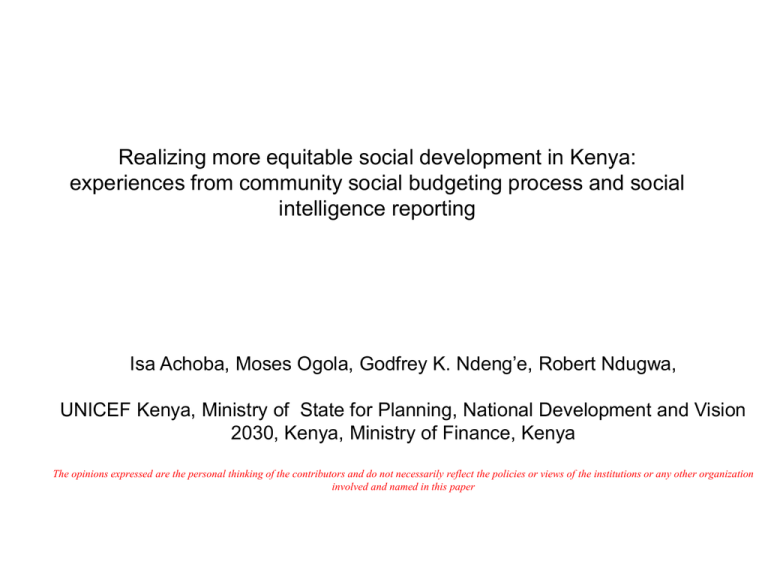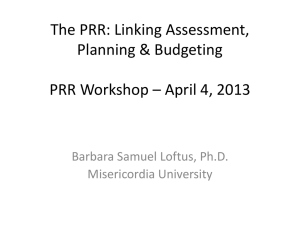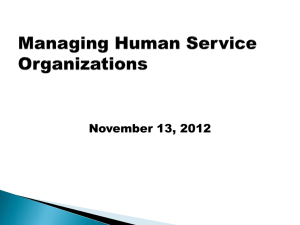Realizing more equitable social development in Kenya
advertisement

Realizing more equitable social development in Kenya: experiences from community social budgeting process and social intelligence reporting Isa Achoba, Moses Ogola, Godfrey K. Ndeng’e, Robert Ndugwa, UNICEF Kenya, Ministry of State for Planning, National Development and Vision 2030, Kenya, Ministry of Finance, Kenya The opinions expressed are the personal thinking of the contributors and do not necessarily reflect the policies or views of the institutions or any other organization involved and named in this paper Content of Presentation Background to Social Budgeting in Kenya The Concept of Social Budgeting Tools and methodology for enhancing Social Budgeting Social Intelligence Reporting District level SIR Facility/Community level SIR Observatories in Social Budgeting. Main findings Recommandations Conclusion The background to Social Budgeting • For many years after independence in Kenya - budgeting was more preoccupied with Macroeconomic issues: Generating higher growth (GDP), controlling inflation, exchange/foreign reserves, debt etc Limited emphasis was given to human development (poverty, health and education) • In 2005 the Government of Kenya in collaboration with UNICEF, conceptualized the social budgeting initiative • Social Budgeting is premised on the need to ensure a balance between macroeconomic goals and social development objectives Dual Budgeting Framework Harmonization Macroeconomic framework Process and Negotiations Growth rate, inflation, fiscal deficit, public debt, taxation Quantitative targets to reduce child deprivation, namely in health, nutrition, housing, information, water, education, sanitation and protection. Resource envelope Mandated expenditures Human Development & rights framework Infrastructure Security HD/HR provisions Children and vulnerable populations Social Policies for Human Development The Concept of Social Budgeting social sectors focusing on children and women participatory approach to budget preparation and monitoring Women and marginalized populations Budgetary decisions, allocations and utilization Development activities are inter-twined – Human rights are holistic Broader Participation ensures ‘equity', 'efficiency’ and ‘accountability’ in social outcomes Policy and institutional hurdles - most visible nearer the ground Ownership and sustainability of development Top Down vs Bottom up Balance Children and vulnerable populations Priorities amidst competing needs – best identified by the people Social Policies for Human Development The Concept of Social Budgeting Addresses policy Barriers social sectors focusing on children and women participatory approach to budget preparation and monitoring Women and marginalized populations Budgetary decisions, allocations and utilization Evidence for Policy Adjustment Human Rights Resources means more than funds Transparent Decision ► Children ► Women ► Media ► Civil Society Recent Developments on Social Budgeting in Kenya 1. Social Budgeting Guidelines Developed Institutionalizes Social Intelligence Reporting (SIR) at district and facility/community levels 2. Capacity developed for bi-annual conduct of Social Intelligence Reporting in the 47 districts (1 per county); 3. Increased Treasury funds to key social sectors in last 3 years…(see table) Free Primary Education Early Childhood Development Education Nutrition Orphans and Vulnerable children cash transfer Older Persons Cash transfer Maternal Voucher scheme Disability Population and family planning Kenya: Growth in selected social subsector budgets Ministry Sub-sector (Kshs Millions) Absolute Per cent 2008/09 2011/12 Change Change 6,678.0 8,500.0 1,822.0 27.3 MoE FPE MoE ECDE 198.0 387.0 189.0 95.5 MoPHS NUTRITION 147.0 238.0 91.0 62 MoPHS OBA 0.0 52.0 52.0 100+ MoGCSD OP-CT 4.0 1,000.0 996.0 100+ MoGCSD OVC-CT 579.0 1,077.0 498.0 86.0 MoGCSD PWD 200.0 667.0 467.0 233.5 MoSPNDV2030 NCAPD 110.0 172.0 62.0 56.4 MoSPNDV2030 CDF 10,100.0 17,900.0 7,800.0 77.2 MoSPNDV2030 SB/SIR 0.0 15.0 15.0 100+ MoF SB/SIR 0.0 15.0 15.0 100+ 196,000.0 326,800.0 130,800.0 66.7 Social Sector Budget Are these Budgets working for children and women? Increasing Social Sector Development Budgets Social Policy Briefs & Advocacy No ‘real time ‘assurances’ of participation and ‘efficiency’ Are Budgets working for Children And Women at facilities And service outlets? Role of Social Budgeting Observatories Social Budget Observatories are useful if ‘facts and figures’ on the ‘budget at work’ is available; The Social Intelligence Reports (SIR) ….’eye, ear and nose’ on budget working for children and women; The Social Budgeting Observatories meet to; • • • • • • Deliberate on the ‘real time’ findings from SIRs; Take and/or ensure that remedial actions do address challenges are dealt with; Hold duty bearers accountable; Foster citizen participation; Contribute to policy performance review, and; Gather evidence for the next budget cycle. Social Intelligence Reporting (SIR) in the context of human rights and development An accountability tool prescribed in the Government of Kenya Social Budgeting (SB) Guidelines to: • Engage ‘Claim Holders’ in budget and social policy; • Gauge the performance of key social policies for the realization of the rights of children and women in an environment of ‘equity’ , ‘participation’, ‘transparency’ and public ‘accountability’. Social Intelligence Report summarizes and analyses data, information and evidence collected from; 1. Social networks, 2. Service points; 3. Community interactions Social Intelligence Reporting (SIR) Methodology •The process of conducting SIR can be categorized into two levels notably; –district/county and –facility/community level. Social Budgeting/Social Intelligence Reporting (SIR) Process Flow Chart National Social Budgeting Observatory (Members: Government (through Permanent Secretaries of line Ministries); Civil Society Organisations; Media, Development Partners; Members of Private Sector (KEPSA) Sectoral Social Budgeting Observatory (Members: Technical Heads of Departments in Government; Civil Society Organizations; Parastatals (SAGAs); Development Partners District Social Budgeting Observatory (Members: Representative of Community (but not MP); District Development and Sectoral Officers (DDE, DPHO, DAO, DWIO ,etc; Children’s’ Representative; Representatives of Local Authorities ; Faith Based Organizations; Constituency Development Fund Committee; Private Sector; District Accountant; Community members (gender balanced); Community/Facility level Women, children, elderly/service providers e.g in schools, health centers, water points Key tasks include: •Set national priorities for Social sector •Review Sector policy briefs and integrated to national budget •Review Sectoral and District Proposals •Ensure equitable distribution of Social Sector services in District to reduce disparities •Prepares operational and policy guidelines on social budgeting Key tasks include: Provides Sectoral linkage between District and National Observatories Monitor and Evaluate ongoing projects in Social Sectors and reports on progress on these Report on Sector Specific policy contribution to Social outcomes for women, children, etc Receive and evaluate Proposals from District observatory; Provide funds and justify this to upper level groups. Through participatory sessions, provides social intelligence on health, education, water, nutrition and social protection services are at the community level and from the Service delivery points. Agree to remedial action and follow up Social Intelligence report Examples of SIR TOOLS Kenya – Social Intelligence Reporting Template and Format D1: Name of Province.................D2: Name of County..................D3: Name of District.................. D4 Name of Constituency................. D5: Name of Division/Ward................ D6: Date............ Examples of SIR TOOLS Health Module -District Level Information 2008/ 2009 2009/ 2010 District Level Funding Information DH1: Amount of Fund received (Ksh) DH1a:MoPHS DH1b:MoMS DH1c: Others (specify) Health Facility Information DH2a-c: Total number of health facilities in district DH3a-c: Total number of ITNs distributed in district DH4: Total number of Public Health personnel by type and gender DH4a: Doctors DH4b: Clinical Officers DH4c: Lab Technicians DH4d: Nurses DH4e: Others DH5: Leading causes of morbidity by gender Kenya shillings Public Male Kenya shilling Faith Based Public Female Male Private 2008/2009 Three leading causes of Notes /Remarks Private Faith Based Female 2009/2010 Three leading causes of How is SIR Generated and Used? Better Social Services Policies Better Development Results SIRs in Practice… @ local levels Participation in mutual Accountability District or County Development Office as Secretariat for SIR District and/or County Development (Executive) Committe As Local Observatory Social Intelligence Reporting… a) Budget b) Policies Are Budgets Working for Children and Women? Education sector funds and Services Health and Nutrition services and funds Social Protection Services and funds Water, Sanitation and Hygiene services and funds What ? Who? Why? Where? When? Devolved Funds – at least 10 of such funds exist today Follow up on SIR key findings and recommendat ions Hold sector offices and officials accountable SIR Engagement Process •Several methods are used to engage the managers and collect the information for SIR, e,g 1. Observations and photography; 2. one-on-one sessions and 3. group discussions with service providers/officials. 4. review of records such as registers for drugs or pupil/patient attendance, minutes of management meetings, financial records 5. a tour of the facility to asses the condition, status and operations of various facilities including toilets and sanitary facilities, class rooms, incinerator, laboratories, wards, drug stores among others within each institution 6. direct engagements with service users’ e.g. pupils in school, mothers attending ANC/patients, and any community members, etc. is also a vital source of credible SIR information Observations & Group discussions Social Intelligence Reporting (SIR) Results • Main Findings from Social Intelligence Reporting (SIR) in Kenya Key Findings from Social Intelligence Reporting….2010 to date The SIRs field diagnostics have so far shown that … 1. Vast ‘real time evidence can stimulate action… o In a district, 21 children are reported pregnant in a primary school alone in 2010; o o o 2. Anti Malaria drugs are lacking , sometimes for months in health facilities No toilet for ECD pupils in primary schools; A former Head teacher & past PTA Chairman in a School could not account for Ksh 130, 000 (from CDF +MVC fund);… CT-OVC is keeping children in schools;… Obstacles on the path of budget removed… e.g. the use Constituency Development Funds for spring water development; In a Primary school, 750 pupils were on roll call, but only half were captured in the Education sector database…denying the school FPE grants Key Findings from Social Intelligence Reporting…. The SIRs field diagnostics is …Revealing and dealing with vulnerabilities 3. In Kinango district , Coast Province of Kenya, the SIR spotted blood in some school toilets, linked up the district health team and was able to unearth and deal with the high prevalence of parasitic infections in the community. 4. The plight of pupils with disability was the focus in Mukuyuni Primary School where the following actions have been agreed: 5. Screening, by the Makueni District health team, of the children in the school and catchment community for the various forms of disabilities; Construction of ramps to ease access to classrooms for the physically challenged pupils in Class 2; Provisioning of toilets for the physically challenged pupils in the school In Mukuyuni Health Centre, a teenage girl was offered antenatal services and counseling towards resumption of schooling – fostering collaboration between the education, health and child protection teams in the district. Key Findings from Social Intelligence Reporting…. The SIRs field diagnostics is …Enforcing and promoting accountability 6. In some primary schools, the conduct of the SIR enabled: The Head teacher to share information on the use of facilty improvement funds more transparently with teachers and parents; Recruit ancillary staff (where none existed) even thought budget ahs been provided; Free pupils from cleaning the toilets, and focusing on their studies; 7. In Mukuyuni health centre, a teenage girl was offered antenatal services and counseling towards resumption of schooling – fostering collaboration between the education, health and child protection teams in the district. Key Findings from Social Intelligence Reporting…. The SIRs field diagnostics is removing…Obstacles to enjoyment of social services 8. In Nakuru, a fully funded water project was not operational due to administrative bottlenecks (water bills not paid promptly, and records in shambles, management committee not transparent etc). 9. The SIR identified and dealt with this in liaison with the Area District Officer (DO) who compelled the old management committee to hand over to the new management. A more transparent and accountable system of fund management was put in place – and water supply services resumed. The diagnostics is …Tracking and providing assurances on social sector investment 10 . In almost all (120) schools visited, the government and donor investment in CT-OVC is keeping vulnerable children in schools and enabling them to learn Recommendations… 1. Sustained national capacity development and integrate Social Budgeting into national policy, planning, budgeting and public accountability framework; 2. Gather evidence for increasing treasury allocations to pro-child and women friendly policies but also assemble facts on how budgets are working for children and women; 3. Strengthen Budgeting Observatories – linked to Social Intelligence Reporting – as means to promote ownership and accountability for effective, equitable and efficient use of resources for the fulfillment of human rights, especially for the most vulnerable; 4. Foster partnership and collaborate with donors and development partners to increase resources (funding, technical, knowledge sharing via south-south cooperation etc) to social budgeting Conclusion Our experiences from Kenya show that…. Social budgeting and Social Intelligence Reporting (SIR) have the potential to promote good governance and the culture of accountability at all administrative levels. Investing in social budgeting could impact positively on citizen participation, delivery of equitable social services and enhance the culture of public accountability








